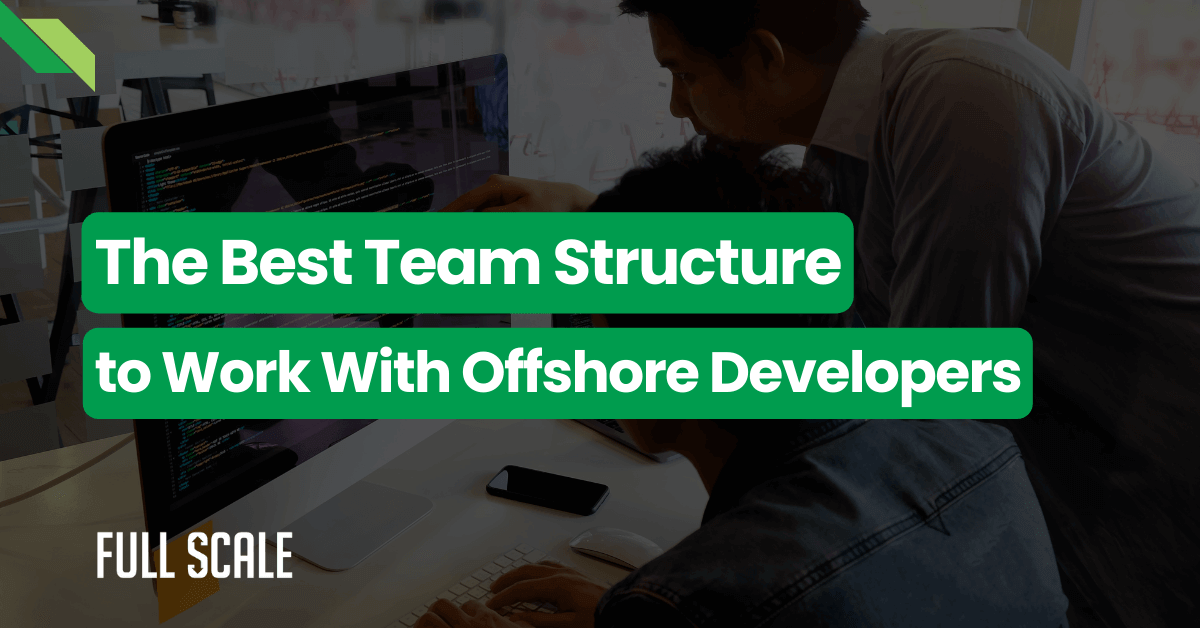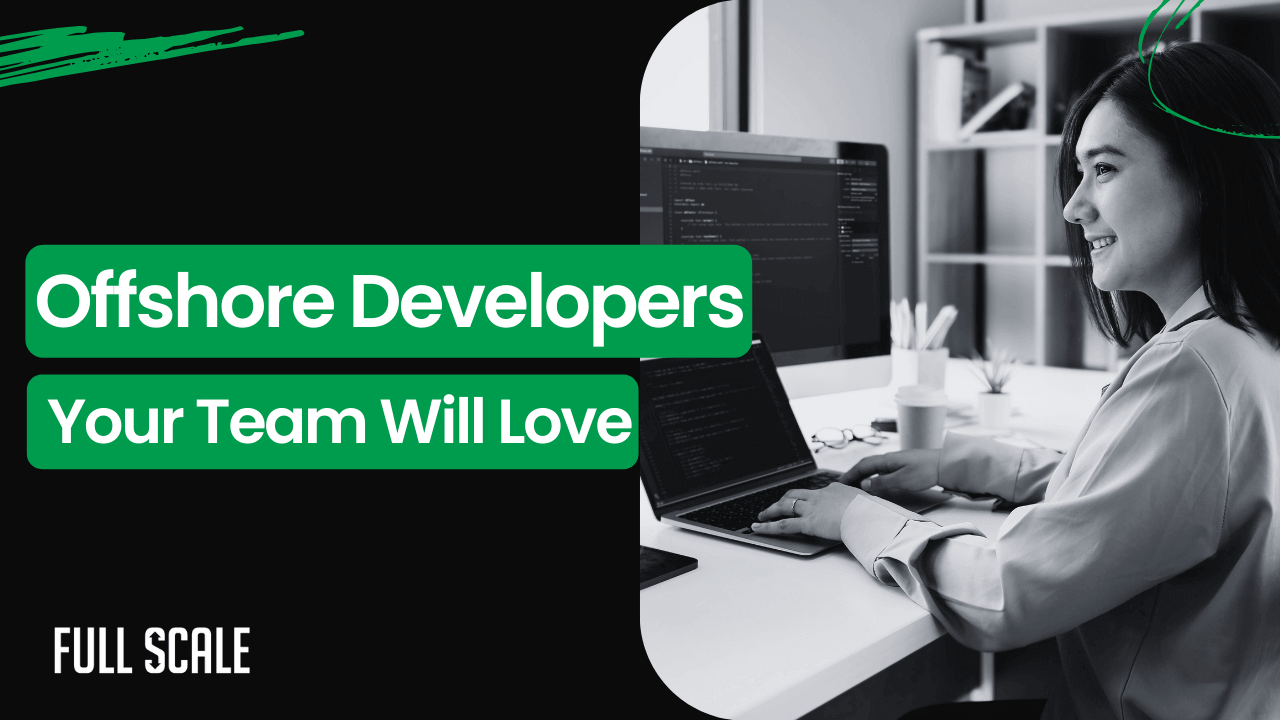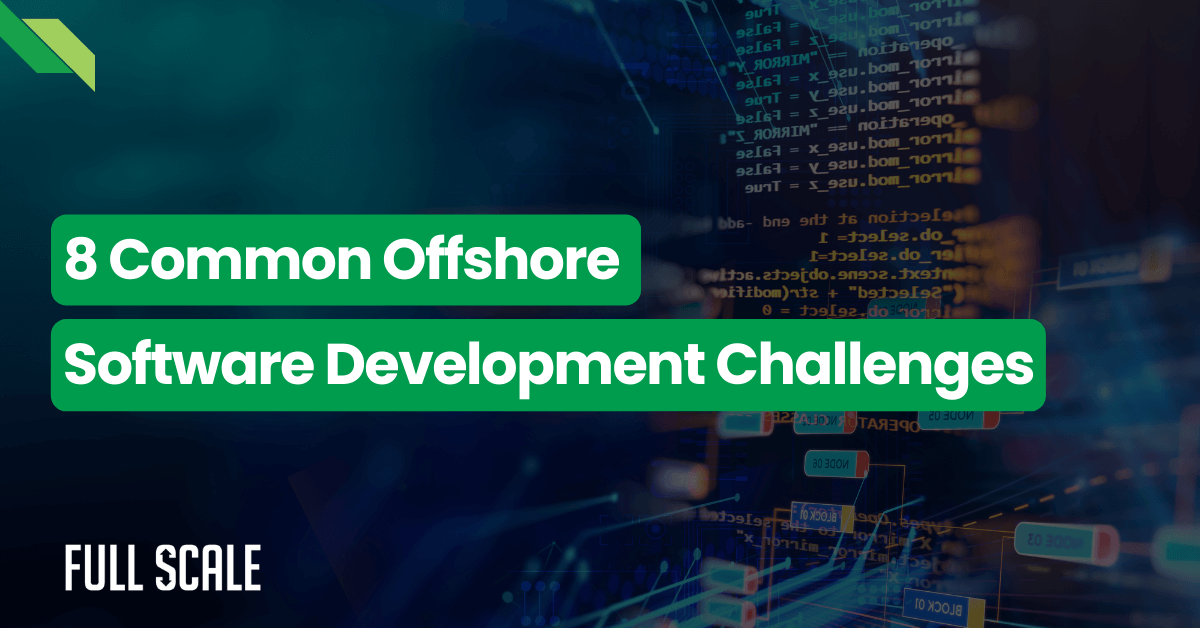To justify offshore development to your CFO, focus on five critical areas:
- Total Cost of Ownership—Show all-in savings ($138K per developer annually)
- Risk Mitigation—Use month-to-month contracts instead of long-term commitments
- Time to Value—Demonstrate 14-21 day hiring vs. 90-120 days locally
- Competitive Positioning—Prove competitors are scaling faster with offshore teams
- Predictability—Provide transparent monthly costs vs. unpredictable local hiring
Start with a 30-day pilot ($12K) to prove the model before scaling. This approach has won budget approval for 60+ tech companies.
But do you know what kills me?
CTOs who’ve figured out they need offshore developers. They’ve done the research. They’ve talked to peers who’ve scaled successfully. They know exactly what they need.
And then finance says no.
Not because the numbers don’t work. Not because it’s a bad idea.
Because you’re speaking two different languages.
Finance speaks spreadsheet. You need to give them one that tells your story.
Here’s the thing nobody tells you: The budget conversation with your CFO isn’t actually about budgets. It’s about risk, predictability, and how you frame the decision.
And here’s what makes 2026 different: Finance isn’t just being cautious—they’re being ruthless.
With recession fears, tighter VC funding, and boards demanding profitability, every dollar you request gets 10x more scrutiny than it did in 2021.
The “we’ll figure out headcount later” days are over. If you don’t lock in the budget now, you won’t get it in Q1.
I’ve watched dozens of CTOs lose this battle. Not because they were wrong—because they walked in talking about “velocity” and “technical debt” when they should’ve been talking about “cost per sprint point” and “risk-adjusted ROI.”
Let me show you how to win it.
Win Your CFO's Approval in One Meeting
The ROI Framework
Build an airtight business case showing $138K savings per developer and 100 days faster to productivity
Finance's Language
Translate tech needs into the 5 metrics CFOs actually care about: TCO, risk, time to value, competition, and predictability
The Pilot Proposal
Close with a $12K, 30-day pilot that makes it impossible for finance to say no
Objection Handling
Respond to every concern about time zones, IP protection, quality, and communication with confidence
Real Conversation Scripts
See exactly how successful CTOs pitched this and won $400K+ in budget approval
The 5-Part Framework
Follow the proven structure that's won approval for 60+ tech companies in their first meeting
Why CTOs Lose Budget Battles (And How to Build a Winning Staff Augmentation Business Case)
Most technical leaders think they lose budget conversations because finance “doesn’t get it.”
Wrong.
Finance gets it just fine. They just don’t trust how you’re presenting it.
Here’s what actually happens:
You walk in talking about how you need more developers to move faster. You throw around terms like “scaling velocity” and “reducing sprint lag.” Maybe you mention that local developers are expensive and you’ve heard offshore could work.
Finance hears: “I want to spend more money to solve a problem I can’t quantify, using a solution I haven’t fully vetted.”
See the disconnect?
The three reasons CTOs lose budget battles:
1. You’re solving a tech problem. They’re solving a business problem.
- You want developers to ship features faster
- They want to know: Will this increase revenue? Reduce churn? Cut costs we can forecast?
2. You’re talking about potential. They’re managing risk.
- You see the upside of moving faster
- They see the downside of an offshore experiment gone wrong
3. You’re thinking quarterly. They’re thinking annually.
- You need to hire NOW to hit Q1 deadlines
- They’re looking at 2026 cash flow, burn rate, and board optics
The mistake isn’t that you don’t understand finance. It’s that you’re not translating your tech needs into their language.
The good news? Once you learn their language, the conversation completely changes.
I've personally sat in this meeting 100+ times. The CFOs who say no aren't being difficult—they're doing their job (protecting the downside). Your job is to show them the offshore pilot has less downside than continuing to hire locally. Once they see that, they always say yes.
Matt Watson, CEO of Full Scale Tweet

What Finance Actually Cares About (Hint: It's Not "Best Practices")
Let me save you some time.
Your CFO does not care about:
- Your tech stack
- Developer happiness scores
- Industry best practices
- What your last company did
Your CFO cares about exactly five things:
1. Total Cost of Ownership (TCO)
Not just salary. Everything.
- Recruitment costs
- Benefits and overhead
- Office space
- Training and ramp-up time
- Turnover and replacement costs
When you say “offshore developers cost less,” finance hears “lower salary.” But what they want to know is: What’s the all-in cost over 12-24 months?
Example of thinking like finance:
Wrong Approach: “Offshore developers cost $50K vs. $150K local”
Right Approach: “Our total cost per developer—including recruitment, overhead, and turnover—drops from $180K to $65K annually with offshore, saving us $115K per seat”
See the difference?
2. Risk Profile
Finance doesn’t hate spending money. They hate unpredictable spending and unquantifiable risk.
What they’re really asking:
- What happens if this doesn’t work?
- How quickly can we course-correct?
- What’s our exit strategy?
This is why staff augmentation beats project outsourcing in budget conversations.
With project outsourcing:
- Large upfront commitment
- Fixed scope (until it’s not)
- Hard to pivot mid-project
- No easy exit
With staff augmentation (our model):
- Month-to-month flexibility
- Scale up or down as needed
- Direct control of developers
- Can stop anytime
Finance loves flexibility. It’s the opposite of risk.
3. Time to Value
How fast do they see results?
- How long until developers are productive?
- When do we ship the first feature?
- What’s the payback period on this investment?
The budget-winning answer:
“We can have two senior developers integrated into our standups within 14 days. They’ll start shipping code in week three. Based on our current feature backlog, we’ll deliver $X in new functionality 3 months faster than if we hired locally—which translates to $Y in earlier revenue.”
Now you’re speaking their language.
4. Competitive Positioning
Finance understands this: If we don’t do this, will we fall behind?
Are competitors moving faster because they’ve figured out offshore hiring? Are we losing deals because our product roadmap is too slow?
Frame it as competitive risk:
“Our two biggest competitors have offshore teams. They’re shipping features 40% faster than us. According to Gartner’s 2024 Strategic Technology Trends report, companies leveraging global talent are gaining significant competitive advantages. We either match their speed or we keep losing deals on product completeness.”
Finance hates falling behind more than they hate spending money.
5. Predictability
This is the big one.
CFOs don’t want surprises. They want to know exactly what they’re spending, when, and what they’re getting for it.
The numbers they need:
- Monthly recurring cost (not vague “estimates”)
- Ramp-up timeline (when does spending start?)
- Expected output metrics (features shipped per quarter)
- Retention rates (how stable is this investment?)
Give them predictability, and they’ll give you a budget.
But wait—what about code quality?
I know what you’re thinking. Cheaper developers = lower quality, right?
Wrong.
The developers we’re talking about aren’t junior contractors. They’re senior engineers with 5-10 years of experience who’ve worked with companies like yours. The difference isn’t skill level—it’s cost of living.
Plus, here’s the counterintuitive part: Offshore teams often have lower technical debt than local teams. Why? Because their retention rate is 95% vs. 13% local turnover according to Bureau of Labor Statistics data. They’re around long enough to own the code they write.
When developers leave every 18 months, they don’t refactor. They ship and run. Long-term teams? They maintain what they build.
The Full Scale Five-Part CFO Framework: How to Justify Offshore Development With ROI Data
Okay. You know what they care about. Now let’s build the pitch.
I’ve seen this framework work with CFOs at 60+ tech companies. It’s not magic—it’s just structure.
We call it The Full Scale Five-Part CFO Framework.
Part 1: The Business Problem (Not the Tech Problem)
Start here. Not with developers. Not with offshore. With the business impact of your current bottleneck.
Bad opening: “We need more developers to increase our velocity.”
Good opening: “We’re currently losing $500K in ARR annually because our product roadmap is 6 months behind competitors. Three major deals last quarter explicitly cited missing features as the reason they went with [Competitor].”
See what happened? You didn’t mention developers yet. You talked about lost revenue.
Formula:
- Quantify the business problem in dollars
- Show the competitive impact
- Make it urgent (time-sensitive)
Part 2: The Local Hiring Reality Check
Now show them why the obvious solution (hire locally) doesn’t work.
Don’t make it about cost yet. Make it about feasibility and time.
The reality check:
“To hire three senior React developers locally:
- Average time to hire: 90-120 days per role (that’s Q1 gone)
- Average salary: $160K + 30% benefits = $208K per developer
- Turnover rate in tech: 13-15% annually = we’ll likely lose one within a year
- Total cost: $624K for three developers, assuming we can even fill the roles
Timeline: Best case, we have a full team by April. Realistically, June.
Problem: By then, we’ve missed our Q1 launch window and [Competitor] has shipped the features we’re planning.”
You just showed them local hiring is expensive, slow, and risky.
Part 3: The Offshore Alternative (With Risk Mitigation)
Here’s where you introduce offshore—but not how most CTOs do it.
Don’t lead with cost savings. Lead with speed and flexibility, then show how the model mitigates their concerns.
The pitch: Staff augmentation through a provider like Full Scale gives us:
Speed:
- Vetted developers available within 2 weeks
- Start integrating into our Slack and standups immediately
- First code shipped within 3 weeks
Flexibility:
- Month-to-month contracts (no long-term commitment if it doesn’t work)
- Scale up or down based on project needs
- Direct control—they work as extensions of our team, not through a middleman
Cost structure:
- $60-70K per senior developer (all-in)
- Transparent monthly billing
- No recruitment fees or overhead
Risk mitigation:
- 95%+ retention rate (vs. 13-15% local turnover)
- U.S.-based contracts for IP protection
- Direct communication—no project managers in the middle
- Can stop anytime if it’s not working.”
Notice what you did:
- Led with business benefits (speed)
- Addressed their risk concerns upfront
- Made the financial case without making it ONLY about savings
- Showed flexibility (their favorite word)
Part 4: The Offshore Development ROI Breakdown
Now give them the spreadsheet.
Finance lives in Excel. Give them numbers they can model.
The comparison table they need:
| Metric | Local Hiring | Staff Augmentation (Full Scale) | Difference |
|---|---|---|---|
| Time to first developer productive | 90-120 days | 14-21 days | ~100 days faster |
| Cost per senior developer (annual, all-in) | $208K | $70K | $138K savings per seat |
| 3 developers, annual cost | $624K | $210K | $414K savings |
| Turnover rate | 13-15% | <5% | More predictable |
| Ramp-up cost | $15K+ per hire (recruiters) | $0 | $45K saved upfront |
| Flexibility to scale | Hire/fire = months + severance | Month-to-month, no severance | Low risk |
| Time to full 3-person team | 6-9 months | 3-4 weeks | 5-8 months faster |
Total first-year savings: $459K Speed advantage: 5-8 months faster to full team
“We can reinvest those savings into product, marketing, or keep it as runway. Either way, we’re moving faster and spending less.”
Part 5: The Pilot Proposal (The Low-Risk Close)
Never ask for full commitment upfront. Give them an easy yes.
The pilot pitch: Here’s what I’m proposing.
- Phase 1 (30 days): Hire two offshore developers, integrate them into one team, test the model
- Cost: $12K total for the month
Success metrics:
- Developers ship code within first 3 weeks
- Team reports positive integration experience
- We hit sprint goals with added capacity
If it works: We scale to 5-6 developers and save $400K+ annually
If it doesn’t: We stop after 30 days, having spent $12K to test it
Question for you: Would you rather spend $12K to test this, or $624K committing to local hiring without knowing if we can even fill the roles?”
You just made it impossible to say no. The risk is tiny. The upside is massive.
Key Takeaways: Winning the Offshore Development Budget Battle
- The Problem: CTOs lose budget battles because they speak tech language, not finance language
- The Solution: Use the Full Scale Five-Part CFO Framework to translate tech needs into CFO priorities
- The Numbers: Save $138K per developer annually, get teams productive 100 days faster
- The Close: Start with a $12K 30-day pilot to derisk the decision
- The Success Rate: This framework has won budget approval for 60+ tech companies
A Real CTO-CFO Budget Conversation (How It Actually Goes Down)
Let me show you how this plays out.
[Meeting starts. You open with Part 1: Business Problem]
You: “Before we talk headcount, I want to show you what it’s costing us not to move faster. Last quarter, we lost three deals worth $180K in ARR because we didn’t have features [Competitor] shipped 6 months ago. That’s $540K in lost revenue this year alone.”
CFO: “Okay, I hear you. But hiring is expensive and takes forever.”
You: “Exactly. That’s the problem. If we hire locally, we’re looking at 4-6 months to get three senior developers onboarded. By then, we’ve missed Q1 and Q2 launch windows. And we’d be spending $624K annually.”
CFO: “So what’s the alternative?”
[You move to Part 3: Offshore Alternative]
You: “Staff augmentation. We bring on vetted offshore developers who work directly with our team—no middlemen. They’re in our Slack, in our standups, fully integrated.”
CFO: “I’ve heard offshore horror stories. Communication issues, quality problems…”
[You handle the objection—this is where Part 3’s risk mitigation comes in]
You: “That’s traditional outsourcing—big agencies with project managers in the middle. This is different. These are dedicated developers who work like they’re on our payroll, just paid through Full Scale. Month-to-month contracts, so if it doesn’t work, we stop. But their retention rate is over 95%, vs. 13% local turnover.”
CFO: “What’s the cost difference?”
[Part 4: ROI Breakdown]
You: “For three senior developers, we’d spend $210K annually vs. $624K local. That’s $414K in savings. Plus we get them in 2-3 weeks instead of 6 months.”
CFO: “That’s a big difference. What’s the catch?”
You: “No catch. Different labor market, lower cost of living. But same quality—these are senior devs with 5-10 years experience. The catch is we have to manage them like any remote team. But we’re already doing that with our U.S. remote engineers.”
CFO: “What if it doesn’t work out?”
[Part 5: Pilot Proposal]
You: “That’s why I’m proposing a 30-day pilot. We bring on two developers, integrate them into one team. Cost is $12K for the month. If they’re not productive within 3 weeks, we stop. If they are, we scale up and save $400K this year.”
CFO: “So we risk $12K to potentially save $400K?”
You: “Exactly. And get to market 5 months faster.”
CFO: “Okay. Let’s try it.”
[Meeting ends. You win.]
How One CTO Won $400K in Budget
I used this exact framework with our CFO. Started with the lost revenue numbers ($300K in missed deals), showed him the 6-month local hiring timeline vs. 3-week offshore timeline, and closed with a $12K pilot. He approved it in the meeting. We now have 8 offshore developers and just closed our Series B.
S.C.
CTO of an SaaS analytics platform
$400K
Budget Secured
8
Offshore Developers
3 Weeks
Time to Team
Common Objections to Justify Offshore Development (And How to Handle Them)
Let’s rapid-fire through the objections you’ll face when trying to justify offshore development to your CFO.
Objection 1: “What about communication issues with time zones?”
Your answer: “The Philippines is 12-13 hours ahead, which actually works well. They work our afternoons/evenings, so we get overnight progress. Plus, we schedule 2-3 hours of overlap for standups and sync meetings. It’s like having a team that codes while we sleep. According to Deloitte’s 2024 Global Outsourcing Survey, 78% of companies report that timezone differences actually improve productivity when managed properly.”
Objection 2: “How do we protect our IP?”
Your answer: “U.S.-based contracts with Full Scale, not individual developer contracts. Same IP protections as local hires. Plus, we control access—they only see what we give them, same as any remote developer.”
Objection 3: “What if we need to let them go?”
Your answer: “Month-to-month contracts. No severance, no legal risk. If someone’s not working out, we replace them within a week. With local hires, we’re stuck with severance costs and 90-day replacement cycles.”
Objection 4: “Our team won’t like working with offshore developers.”
Your answer: “That’s why we pilot with one team first. If integration goes well, we scale. If not, we stop. But I’d also say—our team already works with remote developers across three time zones. This is just another remote team.”
Objection 5: “This feels risky.”
Your answer: “What’s riskier: Spending $12K to test a model that could save us $400K annually, or spending $624K on local hiring that takes 6 months and has 13% turnover? Let’s derisk the decision with a pilot.”
Objection 6: “What about code quality from offshore teams?”
Your answer: “These aren’t junior developers or freelancers. We’re talking about senior engineers with 5-10 years of experience, vetted through a rigorous process. And here’s the counterintuitive part: because retention is 95% vs. 13% local turnover, they’re around long enough to maintain the code they write. Less technical debt, not more.”
You're Not Alone (Every CTO Struggles With This)
Before we go further, let me tell you something:
Every single CTO we work with has lost a budget battle before.
The guy who just closed a $50M Series B? Lost his first offshore pitch.
The CTO at a well-known SaaS company? Finance said no twice before he figured out the right approach.
The woman who built a 40-person offshore team? Her CFO laughed at her the first time she suggested it.
This isn’t a “you” problem. It’s a “nobody taught us how to speak finance” problem.
The good news? Once you learn it, you never lose another budget conversation.
The Follow-Up (Don't Leave Without This)
You crushed the meeting. CFO is on board with the pilot.
Now you need to close it.
Before you leave the room:
- Get verbal commit: “So we’re aligned—I’ll move forward with setting up the 30-day pilot?”
- Define success metrics: “Let’s agree on what success looks like. If they ship code in 3 weeks and the team gives positive feedback, we scale. Sound good?”
- Set timeline: “I’ll have the first two developers start within 2 weeks. We’ll review after 30 days.”
- Get budget allocated: “Can you allocate the $12K for the pilot so I can move forward?”
Send a follow-up email same day:
Thanks for the conversation today. To recap:
-
Pilot: 2 offshore developers, 30 days, $12K
-
Success metrics: Code shipped within 3 weeks, positive team feedback
-
Timeline: Developers start in 2 weeks, review after 30 days
-
Next step: I'll reach out to Full Scale and share a more detailed plan by [date]
Let me know if I missed anything.
Now it’s locked in.
Why This Framework Works (The Psychology Behind It)
Let me tell you why the Full Scale Five-Part CFO Framework wins budget battles.
It’s not about being persuasive. It’s about reducing perceived risk.
Finance’s default answer to new spending is “no”—not because they’re cheap, but because every dollar spent is a dollar of risk. Their job is to protect the downside.
What this framework does:
- Frames the problem as lost opportunity (they’re already “spending” money by moving too slowly)
- Shows local hiring as the risky option (expensive, slow, high turnover)
- Positions offshore as the risk-mitigated alternative (flexible, fast, proven)
- Makes it impossible to say no (pilot costs $12K—lower than one recruiter fee)
You’re not asking them to make a leap of faith. You’re asking them to test something with almost no downside.
That’s how you win.
The Real Reason Most CTOs Don't Do This
You know what’s wild?
Most CTOs know about offshore development works. They’ve seen peers do it successfully. They’ve read the case studies.
But they don’t pull the trigger.
Why?
Because having the budget conversation feels harder than just “making do” with the team you have.
It’s easier to tell yourself:
- “We’ll just work harder.”
- “We’ll hire locally eventuall.y”
- “Maybe next quarter”
But here’s the truth: Every quarter you wait, you fall further behind.
Your competitors aren’t waiting. They’ve already figured this out. They’re scaling faster, shipping more features, and taking market share.
And you’re still waiting for the “right time” to have a tough conversation.
There is no right time. There’s only now.
What Happens Next
You’ve got the framework. You know what finance cares about. You’ve got the scripts.
Here’s what you do:
- Build your pitch deck using the Full Scale Five-Part CFO Framework
- Get your numbers together (current team costs, local hiring estimates, competitive analysis)
- Schedule the meeting with your CFO (don’t wait for budget season—do it now)
- Run the pitch exactly like I showed you
- Close with the pilot proposal (the easy yes)
If you do this, you’ll walk out with budget approval.
And if you want help building the business case, pulling together the ROI numbers, or just talking through how to position this with your CFO?
We do this every week.
We’ve helped 60+ CTOs have this exact conversation. We know what finance wants to hear. We’ve got the case studies, the data, the comparison models.
We can walk you through it.
Remember, your CFO isn’t the enemy. They just speak a different language. Learn it, and you’ll never lose a budget battle again.
$138K per senior developer annually ($208K local all-in vs. $70K offshore), plus $45K in eliminated recruitment fees for a 3-person team. Total first-year savings for three developers: $459K. These numbers are based on our experience with 60+ tech companies and current Stack Overflow Developer Salary data.
Unpredictability and communication issues. Mitigate this with month-to-month contracts (flexibility) and a staff augmentation model with direct integration (no middlemen). This is fundamentally different from traditional project outsourcing, which is where most horror stories come from.
14-21 days to first developer integrated, 3 weeks to first code shipped. Compare that to 90-120 days for local hiring. You can have a full 3-person team productive in under a month vs. 6-9 months for local hiring.
Those stories come from traditional project outsourcing (agencies with middlemen and project managers). Staff augmentation is different—developers work directly with your team as dedicated extensions. No middlemen, no communication barriers. They’re in your Slack, your standups, working the same way as your remote U.S. team.
Start with the business problem (lost revenue, missed deadlines) before mentioning developers. Frame it as: “We’re losing $X annually because our roadmap is behind competitors.” Then show why local hiring doesn’t solve the timing problem. Only then introduce offshore as the faster, lower-risk alternative. Close with a 30-day pilot ($12K) to derisk the decision.
U.S.-based contracts with the staff augmentation provider (like Full Scale), not individual developer contracts. Same IP protections as local hires. Plus, you control access levels—offshore developers only see what you grant them access to, just like any remote team member.
With month-to-month staff augmentation contracts, you can replace non-performing developers within a week with no severance costs. Compare that to local hires where you face severance, legal risk, and 90+ day replacement cycles. The flexibility is one of the biggest advantages.
Set clear metrics before you start:
(1) Code shipped within first 3 weeks
(2) Positive team feedback on integration
(3) Sprint goals met with added capacity
After 30 days, review these metrics with your CFO. If all three are met, you have clear justification to scale.

Matt Watson is a serial tech entrepreneur who has started four companies and had a nine-figure exit. He was the founder and CTO of VinSolutions, the #1 CRM software used in today’s automotive industry. He has over twenty years of experience working as a tech CTO and building cutting-edge SaaS solutions.
As the CEO of Full Scale, he has helped over 100 tech companies build their software services and development teams. Full Scale specializes in helping tech companies grow by augmenting their in-house teams with software development talent from the Philippines.
Matt hosts Startup Hustle, a top podcast about entrepreneurship with over 6 million downloads. He has a wealth of knowledge about startups and business from his personal experience and from interviewing hundreds of other entrepreneurs.




